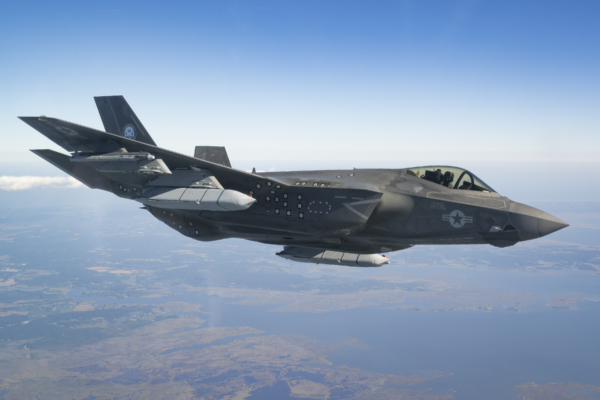Pentagon Releases Photo of F-35C Stealth Fighter Carrying LRASM Missile
The Pentagon has released a photo showing an F-35C stealth fighter carrying an AGM-158C Long-Range Anti-Ship Missile (LRASM), highlighting the importance of this missile for the U.S. military to address potential high-level conflicts with China in the Pacific region.
The AGM-158C LRASM carried by the F-35C is a derivative product of the AGM-158 Joint Air-to-Surface Standoff Missile (JASSM), equipped with a GPS-assisted guidance system that provides the F-35C with powerful anti-surface combat capabilities. Both the F-35 fighter and the AGM-158C LRASM are produced by Lockheed Martin.
The photo released by the Pentagon shows that on September 10, an F-35C carrier-based fighter conducted a test flight from the Naval Air Station Patuxent River in Maryland, with LRASMs visible on the inner wing pylons. This F-35C aircraft is part of the Pax ITF at the Patuxent River.
“As part of ongoing integration efforts, the Pax ITF team conducted a two-day test flight to evaluate the vibrations, loads, and flight qualities of two AGM-158s mounted on external pylons,” the accompanying description of the photo stated. “LRASM is the near-term solution for Offensive Anti-Surface Warfare (OASuW) air-to-surface strike missions, providing flexible, long-range, advanced anti-surface capabilities to counter high-threat maritime targets.”
In addition to the F-35C, LRASM will also be integrated onto the F-35B fighter aircraft for short takeoff and vertical landing. Like JASSM, none of the various versions of the F-35 fighter can internally carry LRASM. While external weapon carriage may detrimentally affect the aircraft’s stealth capability, considering LRASM’s long-range precision strike capability and its own low observability, mounting LRASM on the F-35 is reasonable as the missile’s stealth properties enhance the aircraft’s survivability.
LRASM utilizes a GPS-assisted Inertial Navigation System (INS) guidance system and precise route planning to bring it close to the target area. While en route to the target, the weapon’s highly adaptive routing capability allows it to automatically change course to counter sudden air defense threats detected by LRASM’s built-in Electronic Support Measures (ESM). Updates on other threats are provided by external information sources through data links, enabling LRASM to coordinate actions and conduct cooperative strikes.
Once the missile reaches the target area, the Infrared Imaging (IIR) seeker is activated to guide the missile in the terminal phase of flight. The seeker searches for the target and automatically classifies it using pre-programmed parameters stored in its threat target database. The advanced seeker ensures the missile hits the most vulnerable part of the enemy vessel. As the seeker is passive, the enemy ship cannot detect it, nor can it use radio frequency jamming to counter it.
According to public information, the basic version of JASSM and LRASM have a range between 200 and 300 miles. The AGM-158C-3 version (previously capable of ground attack) will include new software, enhanced over-the-horizon data link, and improved survivability, with a reported range of around 600 miles.
Before the F-35 was authorized to carry LRASM, the U.S. Navy’s F/A-18E/F “Super Hornets” were the only aircraft in the service capable of using this missile variant. The Navy is working to integrate LRASM onto its P-8A “Poseidon” maritime patrol and reconnaissance aircraft.
On April 23 this year, the U.S. Navy conducted a “combat capability graduation exercise” of LRASM stealth missiles by launching four AGM-158C-3 LRASMs from F/A-18E/F carrier-based aircraft, indicating the Navy’s initial testing of AGM-158C-3 LRASMs in a realistic combat application. The success of the testing signifies the Navy’s alignment with the Air Force’s long-standing joint service missile acquisition program.
At that time, Lockheed Martin stated that the missile is designed for “engaging defended maritime surface warfare ships in ways other weapons cannot,” marking a significant development for LRASM.
Chinese media coverage of the U.S. Navy’s test emphasized that while the U.S. military did not specify which “enemies” the missile would target, stealthy air-launched AGM-158C-3 missiles were crucial in recent U.S. war gaming scenarios with China for ensuring “U.S. ultimate victory.”
On July 15th this year, the U.S. Navy announced the first deployment of F-35C carrier-based fighters in Japan to complement the USS Washington carrier strike group. With this deployment, U.S. forces in Japan now have all three F-35 fighter variants.
The Navy press release stated that the F-35C is the Navy’s most powerful fighter, serving as a cornerstone of air superiority and offering a dominant multi-role fifth-generation aircraft for carrier strike groups, enhancing U.S. power projection and deterrence capabilities.
Reported by Nikkei News, Masashi Murano, the Japan Chair at the Hudson Institute in Washington, mentioned that the superior network and stealth capabilities of the F-35C outstrip any upgrades to fourth-generation fighters like the F/A-18 Hornet.
Murano told Nikkei that the F-35C not only provides tactical advantages for U.S. Navy aircraft in air-to-air combat with new Chinese fighters but also effectively counters Chinese anti-ship ballistic missiles and anti-ship cruise missiles launched by bombers.

